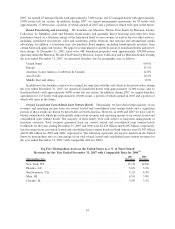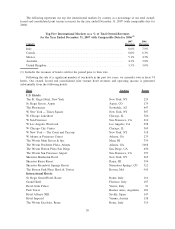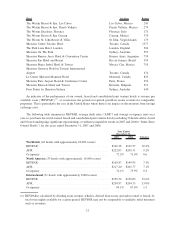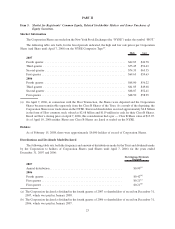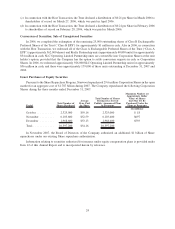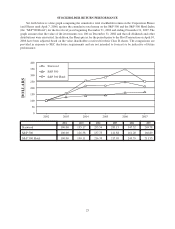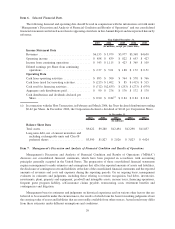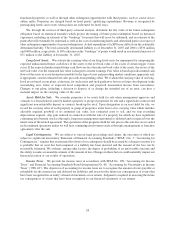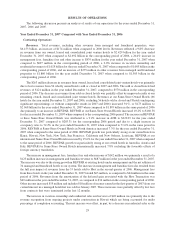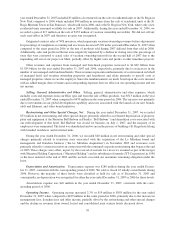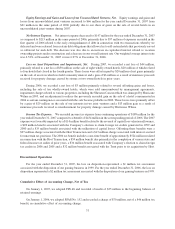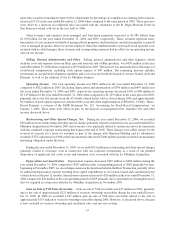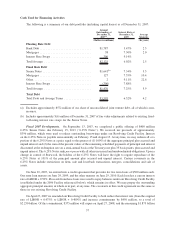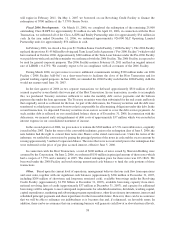Starwood 2007 Annual Report Download - page 92
Download and view the complete annual report
Please find page 92 of the 2007 Starwood annual report below. You can navigate through the pages in the report by either clicking on the pages listed below, or by using the keyword search tool below to find specific information within the annual report.franchised properties as well as through other redemption opportunities with third parties, such as conversion to
airline miles. Properties are charged based on hotel guests’ qualifying expenditures. Revenue is recognized by
participating hotels and resorts when points are redeemed for hotel stays.
We, through the services of third-party actuarial analysts, determine the fair value of the future redemption
obligation based on statistical formulas which project the timing of future point redemption based on historical
experience, including an estimate of the “breakage” for points that will never be redeemed, and an estimate of the
points that will eventually be redeemed as well as the cost of reimbursing hotels and other third parties in respect of
other redemption opportunities for point redemptions. Actual expenditures for SPG may differ from the actuarially
determined liability. The total actuarially determined liability as of December 31, 2007 and 2006 is $536 million
and $409 million, respectively. A 10% reduction in the “breakage” of points would result in an estimated increase of
$71 million to the liability at December 31, 2007.
Long-Lived Assets. We evaluate the carrying value of our long-lived assets for impairment by comparing the
expected undiscounted future cash flows of the assets to the net book value of the assets if certain trigger events
occur. If the expected undiscounted future cash flows are less than the net book value of the assets, the excess of the
net book value over the estimated fair value is charged to current earnings. Fair value is based upon discounted cash
flows of the assets at a rate deemed reasonable for the type of asset and prevailing market conditions, appraisals and,
if appropriate, current estimated net sales proceeds from pending offers. We evaluate the carrying value of our long-
lived assets based on our plans, at the time, for such assets and such qualitative factors as future development in the
surrounding area, status of expected local competition and projected incremental income from renovations.
Changes to our plans, including a decision to dispose of or change the intended use of an asset, can have a
material impact on the carrying value of the asset.
Assets Held for Sale. We consider properties to be assets held for sale when management approves and
commits to a formal plan to actively market a property or group of properties for sale and a signed sales contract and
significant non-refundable deposit or contract break-up fee exist. Upon designation as an asset held for sale, we
record the carrying value of each property or group of properties at the lower of its carrying value which includes
allocable segment goodwill or its estimated fair value, less estimated costs to sell, and we stop recording
depreciation expense. Any gain realized in connection with the sale of a property for which we have significant
continuing involvement (such as through a long-term management agreement) is deferred and recognized over the
initial term of the related agreement. The operations of the properties held for sale prior to the sale date are recorded
in discontinued operations unless we will have continuing involvement (such as through a management or franchise
agreement) after the sale.
Legal Contingencies. We are subject to various legal proceedings and claims, the outcomes of which are
subject to significant uncertainty. Statement of Financial Accounting Standards (“SFAS”) No. 5, “Accounting for
Contingencies,” requires that an estimated loss from a loss contingency should be accrued by a charge to income if it
is probable that an asset has been impaired or a liability has been incurred and the amount of the loss can be
reasonably estimated. We evaluate, among other factors, the degree of probability of an unfavorable outcome and
the ability to make a reasonable estimate of the amount of loss. Changes in these factors could materially impact our
financial position or our results of operations.
Income Taxes. We provide for income taxes in accordance with SFAS No. 109, “Accounting for Income
Taxes,” and Financial Accounting Standards Board Interpretation No. 48, “Accounting for Uncertainty in Income
Taxes” (“FIN 48”). The objectives of accounting for income taxes are to recognize the amount of taxes payable or
refundable for the current year and deferred tax liabilities and assets for the future tax consequences of events that
have been recognized in an entity’s financial statements or tax returns. Judgment is required in assessing the future
tax consequences of events that have been recognized in our financial statements or tax returns.
28



